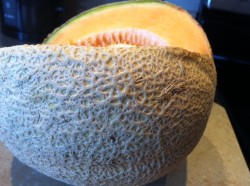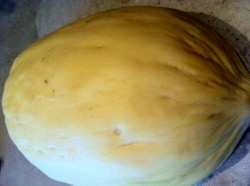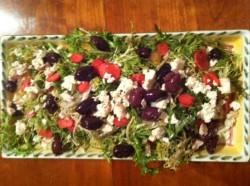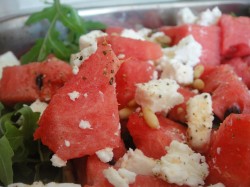Buying: A melon in general should be heavy for it’s size and without bruises. The undertones of the melon should be more yellow than green. Cantaloupe are considered to be netted melons as their surface skin is covered in a web of netted veins. The veins should be pronounced and golden, not green. The inside cavity also contains seeds that are enclosed in a netted web. Knocking on the melon is one way of seeing if it is ripe enough to eat – the cavity inside should sound hollow whereas a honeydew’s seeds will rattle inside when ripe. Like most fruit, trust your nose and smell the fruit, the aroma should be incredibly fragrant. Watermelons are part of the melon family that have smooth skins. They should have a deep, rich skin color and a waxy surface. “Sugar spots” are a good indicator of a good smooth-skinned melon; they are brown flecks that supermarkets usually wash off as imperfections. Crenshaw melons, long and oval in shape, are the most aromatic when ripe and should have a bright yellow skin covering a golden pink flesh. Honeydew should have a smooth, pale yellow-green surface. The blossom end should be rather soft with a slight fragrant aroma. French melons are small and have a grayish yellow-green skin. With its flowery aroma, it is easy to tell when it is ripe as it look as though it is about to burst open.

Storage: An whole, unripe melon should be left at room temperature. Cut melon should not be left out at room temperature for more than 2 or at most 4 hours and for a chilled melon, refrigerate it only overnight. After being picked, a melon will continue to soften, but it will not get any sweeter. Do not put melon in the fridge with strong smelling foods as they will easily absorb those other flavors.

Medical: Watermelon and cantaloupe have a low calorie count (one cup of cantaloupe = 56 calories, watermelon 48 calories). With its orange flesh, cantaloupe is very high in beta-carotene, which is good for your eye sight, so it is very high in Vitamin A, which is good for lung health. It also contains a high amount of Vitamin C which not only acts as an antioxidant, but it protects the immune system by encouraging white blood cells to fight against infections, kill bacteria and viruses, and rejuvenates inactive Vitamin E within the body. Cantaloupe is also high in potassium and dietary fiber. The B Vitamins cantaloupe contains help process carbohydrates and along with the amount of fiber, regulates the flow of sugar into the bloodstream. Watermelon is filled with lycophene which is very strongly preventive of cancer.
Fact: Melons are related to squash, pumpkins, and plants that grow off vines on the ground. What we call cantaloupe in America is actually a muskmelon. The true variety of cantaloupe is found mostly in France. Cantaloupe were first cultivated in 1700 A.D. in Italy in a town called Cantalup, where its name derives from.
Cooking:
Melon has so much more to offer than just in a fruit salad. I made a refreshing chilled melon soup the other day with half a crenshaw and half a french melon I had pureed with half a cucumber, lime juice, basil, a jalapeno, and water to smooth out the consistency. Juicy melon is great wrapped in salty serrano ham or prosciutto. Melon Salsa. Great for parties: cut a hole in a watermelon and carve out some of the flesh. Stick in a funnel and slowly pour in vodka, it will take time to absorb so do ahead...or cut the melon up, stick it in a bowl and pour the vodka over.
Melon Salad
About 5 lbs assorted melons, room temperature, cut into any free-form desired shape, slice, cube or ball.
1 head frisee, washed and dried
12 small French breakfast radishes, trimmed and thinly sliced
1/4 cup extra virgin olive oil
2 tablespoons balsamic vinegar
salt
3 oz feta cheese, drained, cut into 1/2 inch cubes
1/4 cup pitted Kalamata olives, quartered lengthwise
small mint leaves (optional)
Pour the oil and vinegar in a bowl and swirl to make a vinaigrette. Toss the frisee and radishes in a medium bowl and drizzle about half of the vinaigrette around the sides of the bowl. Toss to coat and season to taste. Arrange some of the melon on a serving platter, drizzle with some vinaigrette and repeat with more melon and vinaigrette, layering as you build the salad. Loosely place the lettuce on top of the melon then scatter with feta cheese and olives. Garnish with mint leaves.

* Adapted from Thomas Kellar’s Ad Hoc at Home. The sweet melon goes fabulously with the salty cheese and olives and the slight bitterness of the frisee. I made this salad with only a Crenshaw melon and it was delicious, although a variety of melons would add more color, an array of texture and a medley of flavor. He also included toasted pine nuts and 1 English cucumber which I did not have. I used some pickled radishes I had made rather than small wedges like his recipe called for (boil 2 parts vinegar to 1 part sugar, 1 part water and let cool, add radishes – or any veg – into a canning jar and pour the room-temp pickling liquid over them, let stand for 30 minutes, cover, refrigerate up to 1 month)
 Watermelon, cut into cubes, goes fantastically with some feta cheese, red onion, pine nuts, and fresh basil. Drizzle with some good extra virgin olive oil, a sprinkle of sea salt and a generous amount of freshly ground black pepper.The juicy sweetness of melon pairs incredibly well with salty foods – like feta – so wrapped slices of melon with prosciutto is delicious and easy. Try it grilled!
Watermelon, cut into cubes, goes fantastically with some feta cheese, red onion, pine nuts, and fresh basil. Drizzle with some good extra virgin olive oil, a sprinkle of sea salt and a generous amount of freshly ground black pepper.The juicy sweetness of melon pairs incredibly well with salty foods – like feta – so wrapped slices of melon with prosciutto is delicious and easy. Try it grilled!
About 5 lbs assorted melons, room temperature, cut into any free-form desired shape, slice, cube or ball.
1 head frisee, washed and dried
12 small French breakfast radishes, trimmed and thinly sliced
1/4 cup extra virgin olive oil
2 tablespoons balsamic vinegar
salt
3 oz feta cheese, drained, cut into 1/2 inch cubes
1/4 cup pitted Kalamata olives, quartered lengthwise
small mint leaves (optional)
Pour the oil and vinegar in a bowl and swirl to make a vinaigrette. Toss the frisee and radishes in a medium bowl and drizzle about half of the vinaigrette around the sides of the bowl. Toss to coat and season to taste. Arrange some of the melon on a serving platter, drizzle with some vinaigrette and repeat with more melon and vinaigrette, layering as you build the salad. Loosely place the lettuce on top of the melon then scatter with feta cheese and olives. Garnish with mint leaves.

* Adapted from Thomas Kellar’s Ad Hoc at Home. The sweet melon goes fabulously with the salty cheese and olives and the slight bitterness of the frisee. I made this salad with only a Crenshaw melon and it was delicious, although a variety of melons would add more color, an array of texture and a medley of flavor. He also included toasted pine nuts and 1 English cucumber which I did not have. I used some pickled radishes I had made rather than small wedges like his recipe called for (boil 2 parts vinegar to 1 part sugar, 1 part water and let cool, add radishes – or any veg – into a canning jar and pour the room-temp pickling liquid over them, let stand for 30 minutes, cover, refrigerate up to 1 month)
 Watermelon, cut into cubes, goes fantastically with some feta cheese, red onion, pine nuts, and fresh basil. Drizzle with some good extra virgin olive oil, a sprinkle of sea salt and a generous amount of freshly ground black pepper.The juicy sweetness of melon pairs incredibly well with salty foods – like feta – so wrapped slices of melon with prosciutto is delicious and easy. Try it grilled!
Watermelon, cut into cubes, goes fantastically with some feta cheese, red onion, pine nuts, and fresh basil. Drizzle with some good extra virgin olive oil, a sprinkle of sea salt and a generous amount of freshly ground black pepper.The juicy sweetness of melon pairs incredibly well with salty foods – like feta – so wrapped slices of melon with prosciutto is delicious and easy. Try it grilled!
No comments:
Post a Comment